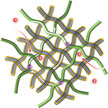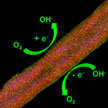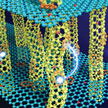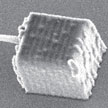Showing Spotlights 33 - 40 of 318 in category All (newest first):
 The space industry has a strong requirement to develop flexible electrostatic discharge protection layers for the exterior cover of satellites in order to protect the electronics of the spacecraft. A new study explores carbon nanotube-polyimide composite materials as a flexible alternative for the currently used indium tin oxide (ITO) coating, which is brittle and suffers from severe degradation of the electrical conductance due to fracture of the coating upon bending.
The space industry has a strong requirement to develop flexible electrostatic discharge protection layers for the exterior cover of satellites in order to protect the electronics of the spacecraft. A new study explores carbon nanotube-polyimide composite materials as a flexible alternative for the currently used indium tin oxide (ITO) coating, which is brittle and suffers from severe degradation of the electrical conductance due to fracture of the coating upon bending.
Nov 26th, 2014
 There has been a long debate in the nanotube community regarding the photocurrent generation mechanisms in individual nanotube devices. In early optoelectronic studies with single-walled carbon nanotubes, the interpretation of photocurrent was mostly based on photovoltaic mechanisms. In new work, researchers use the extra tunability of a double-gated device to conclusively demonstrate that strong photothermal effects are present in carbon nanotube devices.
There has been a long debate in the nanotube community regarding the photocurrent generation mechanisms in individual nanotube devices. In early optoelectronic studies with single-walled carbon nanotubes, the interpretation of photocurrent was mostly based on photovoltaic mechanisms. In new work, researchers use the extra tunability of a double-gated device to conclusively demonstrate that strong photothermal effects are present in carbon nanotube devices.
Nov 4th, 2014
 Inspired by nature's ingenious biological designs, researchers have persistently attempted to mimic these biofunctionalities to bring technological breakthroughs. One of these morphologies - the unique shape of a helical coil - is not only interesting from a scientific standpoint but also pivotal, offering DNA its distinctive properties and propelling flagella in viscous fluids, to name a few. With the advent of personalized medicine on the horizon, researchers are now trying to use tiny springs made of carbon nanotubes, i.e. nanocoils, to propel nanorobots to perform microsurgeries.
Inspired by nature's ingenious biological designs, researchers have persistently attempted to mimic these biofunctionalities to bring technological breakthroughs. One of these morphologies - the unique shape of a helical coil - is not only interesting from a scientific standpoint but also pivotal, offering DNA its distinctive properties and propelling flagella in viscous fluids, to name a few. With the advent of personalized medicine on the horizon, researchers are now trying to use tiny springs made of carbon nanotubes, i.e. nanocoils, to propel nanorobots to perform microsurgeries.
Oct 31st, 2014
 Researchers have created a free-standing carbon nanotube paper electrode with high sulfur loading for lithium-sulfur batteries employing a bottom-up strategy to design and fabricate a hierarchical structure. This new fabrication method does not employ aluminum foil or binders, thereby fully utilizing the advantage of a Li-S system with high specific capacity. This proof-of-concept experiment indicates that the rational design of the nanostructured electrode offers the possibility to efficiently use the active materials at practical loading.
Researchers have created a free-standing carbon nanotube paper electrode with high sulfur loading for lithium-sulfur batteries employing a bottom-up strategy to design and fabricate a hierarchical structure. This new fabrication method does not employ aluminum foil or binders, thereby fully utilizing the advantage of a Li-S system with high specific capacity. This proof-of-concept experiment indicates that the rational design of the nanostructured electrode offers the possibility to efficiently use the active materials at practical loading.
Oct 17th, 2014
 Researchers have demonstrated a unique coaxial carbon nanocable material with pristine carbon nanotubes as the core and nitrogen-doped wrinkled carbon layer as the shell. The active sites rendered by the surface enriched dopant atoms on the carbon nanocables are accessible and effective to catalyze the oxygen involved electrochemical reactions. These coaxial nanocables afford higher ORR/OER current compared with the routine bulk doped nitrogen-doped carbon nanotubes.
Researchers have demonstrated a unique coaxial carbon nanocable material with pristine carbon nanotubes as the core and nitrogen-doped wrinkled carbon layer as the shell. The active sites rendered by the surface enriched dopant atoms on the carbon nanocables are accessible and effective to catalyze the oxygen involved electrochemical reactions. These coaxial nanocables afford higher ORR/OER current compared with the routine bulk doped nitrogen-doped carbon nanotubes.
Oct 10th, 2014
 Researchers consider the rational combination of carbon nanotubes (CNTs) and graphene into three-dimensional hybrids an effective route to amplify the inherent physical properties at the macroscale. By in situ nitrogen doping and structural hybridization of carbon nanotubes and graphene, researchers have now successfully fabricated nitrogen-doped aligned carbon nanotube/graphene sandwiches. In this work, aligned CNTs and graphene layers were anchored to each other, constructing a sandwich-like hierarchical architecture with efficient 3D electron transfer pathways and ion diffusion channels.
Researchers consider the rational combination of carbon nanotubes (CNTs) and graphene into three-dimensional hybrids an effective route to amplify the inherent physical properties at the macroscale. By in situ nitrogen doping and structural hybridization of carbon nanotubes and graphene, researchers have now successfully fabricated nitrogen-doped aligned carbon nanotube/graphene sandwiches. In this work, aligned CNTs and graphene layers were anchored to each other, constructing a sandwich-like hierarchical architecture with efficient 3D electron transfer pathways and ion diffusion channels.
Sep 12th, 2014
 The microstructures of carbon nanotube assemblies determine their properties, for example, highly graphitized CNTs exhibit excellent mechanical and electrical properties; while CNTs with defects and poor crystallinity are beneficial for research on field emission property and hydrogen storage capacity. Therefore, it is of vital importance to control the CNT microstructures effectively for desired applications. A new technique can solve a problem of three-dimensional orientation control of CNTs in microscopic scale.
The microstructures of carbon nanotube assemblies determine their properties, for example, highly graphitized CNTs exhibit excellent mechanical and electrical properties; while CNTs with defects and poor crystallinity are beneficial for research on field emission property and hydrogen storage capacity. Therefore, it is of vital importance to control the CNT microstructures effectively for desired applications. A new technique can solve a problem of three-dimensional orientation control of CNTs in microscopic scale.
Jun 30th, 2014
 Researchers report for the first time the fabrication and measurement of all-inkjet-printed, all-air-processed organic solar cells. Organic photovoltaic technologies have the potential to become a thin-film alternative to inorganic silicon photovoltaics due to their intrinsic potential for low-cost print processing from solution - high-speed and at low temperature. Organic solar cells can be integrated into building facades and windows because they are optically translucent and can be manufactured on large areas at high throughput.
Researchers report for the first time the fabrication and measurement of all-inkjet-printed, all-air-processed organic solar cells. Organic photovoltaic technologies have the potential to become a thin-film alternative to inorganic silicon photovoltaics due to their intrinsic potential for low-cost print processing from solution - high-speed and at low temperature. Organic solar cells can be integrated into building facades and windows because they are optically translucent and can be manufactured on large areas at high throughput.
Jun 16th, 2014
 The space industry has a strong requirement to develop flexible electrostatic discharge protection layers for the exterior cover of satellites in order to protect the electronics of the spacecraft. A new study explores carbon nanotube-polyimide composite materials as a flexible alternative for the currently used indium tin oxide (ITO) coating, which is brittle and suffers from severe degradation of the electrical conductance due to fracture of the coating upon bending.
The space industry has a strong requirement to develop flexible electrostatic discharge protection layers for the exterior cover of satellites in order to protect the electronics of the spacecraft. A new study explores carbon nanotube-polyimide composite materials as a flexible alternative for the currently used indium tin oxide (ITO) coating, which is brittle and suffers from severe degradation of the electrical conductance due to fracture of the coating upon bending.

 Subscribe to our Nanotechnology Spotlight feed
Subscribe to our Nanotechnology Spotlight feed





